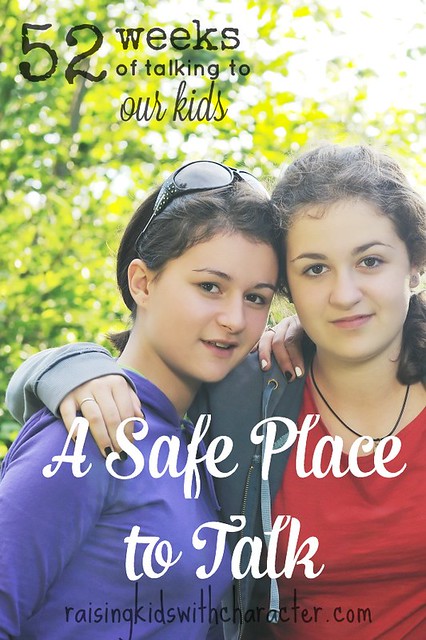“I just don’t feel like I can tell you anything.”
“You judge everything I say.”
“I know you won’t want to listen to this.”
These are all phrases that our preteens, teens, and young adults might say to us—IF we do not open our hearts to them early and often, creating a safe place for them to talk to us.
A pivotal, crucial time to talk to our kids is when they need a safe place to talk.
They need to know that it is safe to tell you whatever is going on in their hearts and lives. They need to know that you won’t completely freak out (even if you don’t agree)—and that you will love them regardless of what they say in these talks.
Our oldest son and daughter (ages 34 and 30) were raised in a pretty strict home. We had rules that did not have logical reasons (see our Reason for Rebellion: Rules Without Reasons in this 52 Times to Talk series…).
We were oftentimes lost, exhausted caring for small children and emotionally drained trying to help young teenagers find their way. However, our son told us that he never wanted to turn away from us—in spite of our many faults—because no matter what we made him do, wear, or say, we always gave him “intellectual freedom”—freedom to believe and think for himself (with our guidance but not with an iron fist).
He knew that we were a safe place. That he could come to us always and we would listen.
This is a tricky thing—we want to enforce our rules. We want to be good parents with strong values and yes, sometimes, even the strictness that it takes to raise children with solid boundaries and internal compasses.
I’m not saying that we didn’t still have our rules. I’m not saying that everything just became a free-for-all in an attempt to provide a safe talking place.
We found that we didn’t have to indulge in order to provide safe places for our kids to talk.
More than anything, we had to provide availability—availability is the greatest safety feature we can offer our kids for talking. If we are there for them continually from young ages, we will be able to provide that safe place over time.
They will come to use more and more, and we will listen and listen and listen.
Creating a Safe Place to Talk
We have found three things to help provide this safety for our kids:
1) The aforementioned availability. We will get better and better at providing a safe place to talk as we make ourselves available.
2) Make it a point of not fixing every time you talk. At first, as you are trying to create the safe talking place, you might even have to make a rule within yourself that you will not correct, instruct, discipline, or advise for a while. This will force you to learn how to provide a safe place. Will you need to correct, instruct, discipline, or advise later? Definitely. But as you listen more and more, you will get better at providing that safe place.
3) Tell your kids that there will always be consequences for actions, and that while you will possibly need to enforce consequences, their coming to you for everything is the safest way to go. That things will always go better if they come to you.
Truly, our kids need a safe place. And it’s up to use to provide it.
And they will feel safe…because we will be that safe place for them.




